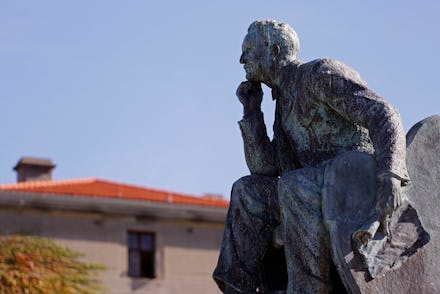Why America Should Keep Its Racist Monuments

Student activists at the University of Cape Town (UCT) in South Africa made international headlines last week after demanding the school remove a bronze statue of British colonizer Cecil Rhodes.
30-year-old Chumani Maxwele emptied a bucket of excrement on the statue as a defiant protest against UCT's decision to continue to host the monument to Rhodes, who was, in addition to being the university's land benefactor, an outspoken racial supremacist.
Others took a subtler approach, using social media outlets like Twitter to demand #RhodesMustFall.
The #RhodesMustFall demand is shaped by the historical context of South Africa — a country just 21 years past the brutal system of apartheid — and UCT students, as well as those within the broader South African community, certainly have a right to protest. But erasing evidence of the worst of a nation's history may not be the answer. On the contrary, preserving these monuments prevents us from lying about gross atrocities committed in the name of the state.
Indeed, America could certainly benefit from having honest conversations about race and history like those being had in South Africa as a result of these protests. In a country where people are expected to "get over" colonization and slavery, publicly displayed symbols of racial antagonism force the public to remember.
The U.S. suffers from historical amnesia: Americans tend to be selective regarding which aspects of our collective past we choose to acknowledge. The U.S. National Park Service, for example, manages more than 100 memorials that serve more as celebratory forms of iconography than symbols of necessary critique. However, there are no bona fide public symbols in the form of a monument or memorial in the U.S. (managed by the NPS) signifying our country's remorse for hundreds of years of willful acts of systemic colonization, racial oppression and the political and economic disenfranchisement of indigenous, African-descended and other non-white peoples on this land. Yet many NPS memorials celebrate people, places or artifacts that are symbols of racial antagonism.
To be clear, a racist monument can be defined as one that honors people who oppressed minorities in their personal lives, like George Washington, or symbols named after famous people known for waging public fights against minority groups, like the Edmund Pettus Bridge.
The infamous bridge, which connects Selma and Montgomery in Alabama, is named after a former U.S. senator who was once a Grand Dragon of the Alabama Ku Klux Klan, as well as an ardent supporter of racial segregation. It is no coincidence that 50 years ago, the bridge was also the site where a crowd of mostly black protesters were brutally attacked by police on what came to known as Bloody Sunday.
As of Wednesday afternoon, the U.S.-based, millennial-led organization named Students Unite had gathered 175,960 signatures on a petition demanding that the NPS rename the bridge. While the efforts of Students Unite are valiant, the Edmund Pettus Bridge is a crucial and regrettable fixture in the American story of racial supremacy that we should not forget.
Americans should not remove other similarly racially-charged symbols from public space for the same reason: Doing so would make the difficult work of reckoning with the harsh realities of our past too easy.
Not all people agree with that approach, of course, and Students Unite is not alone in thinking that symbols of a racist past have no place in today's society. In a Mic poll conducted through Google Consumer Surveys, the majority of respondents agreed that racist artifacts and monuments should be removed from public spaces:
When probed about the removal of specific symbols like George Washington monuments or any statue of a person who played a part in oppressing minorities, however, most answered "no."
These responses suggest that people perceive these symbols as significant artifacts in American history, which they certainly are. But they also suggest both a lack of historical knowledge and a judgment regarding what elements of our nation's history we choose to value. Although George Washington is celebrated as the first president of the U.S., he was also a slave owner, whom University of Delaware professor Erica Armstrong Dunbar labeled "Slave Catcher" in a recent New York Times op-ed.
The question thus becomes: What do these symbols actually stand for? The removal of racist artifacts won't necessarily heal the deep wounds caused by racial antagonism in this country, but remembering all aspects of our historical context might. And it is arguably important to recast relics of a racist past as reminders of how far we've come — and how far we still need to go — rather than sweep them away, as if these ongoing struggles have been overcome.
Regardless, the display of these symbols hints that we choose to remember and even celebrate some racists as heroes, while we ignore the plights of those impacted by racism in this country. These symbols remind of us of the ugliness of our past and the ways we, in the present, must always be brave enough to not forget or repeat the sins of our fathers.
Keep the symbols, and America will keep the historical narrative honest.